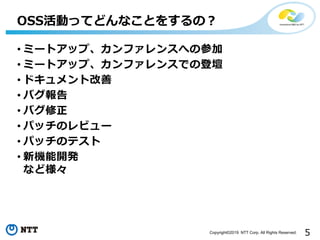OSS活動のやりがいとそれから得たもの - PostgreSQLコミュニティにて -
- 1. Copyright©2019 NTT Corp. All Rights Reserved. OSS活動のやりがいとそれから得たもの - PostgreSQLコミュニティにて - NTT OSSセンタ 澤田 雅彦 Developers Summit 2019 (C-1)
- 2. 2Copyright©2019 NTT Corp. All Rights Reserved. 業務としてのOSS活動(PostgreSQLの例) PostgreSQL ユーザ (NTTグループ) NTT OSSセンタ PostgreSQL コミュニティ フィードバック • ユーザからのフィー ドバックを PostgreSQLに直接反 映する • 企業・個人としての 強みにも繋がる • 技術力、提案力の強 化ノウハウ展開・ サポート提供
- 3. 3Copyright©2019 NTT Corp. All Rights Reserved. • オープンな開発体制 • 特定の企業などに依存せず、誰でも自由に開発に参加可能 • 合意を基本とする意思決定 • ソースコードの追加変更は、メーリングリストでの合意が前提 PostgreSQLコミュニティ
- 4. 4Copyright©2019 NTT Corp. All Rights Reserved. • PostgreSQL Global Development Group • OSSセンタからは8名参加、うち1名はCommitterとして参加 開発体制 5名 ・コミュニティ運営の 種々取りまとめ 28名 ・ソースコードを 追加変更できる 権限を有する 約300名 ・パッチの開発 ・パッチのレビュー 図は次の発表資料から引用: 「De-mystifying contributing to PostgreSQL」(PGCon 2018) 人数は不明 ・出力メッセージの 翻訳など
- 5. 5Copyright©2019 NTT Corp. All Rights Reserved. • ミートアップ、カンファレンスへの参加 • ミートアップ、カンファレンスでの登壇 • ドキュメント改善 • バグ報告 • バグ修正 • パッチのレビュー • パッチのテスト • 新機能開発 など様々 OSS活動ってどんなことをするの?
- 6. 6Copyright©2019 NTT Corp. All Rights Reserved. 技術サポート対応で出てくる問題や、検証作業等で不便 と感じた点を直すことが多い 例 • 想定どおりにBEFORE ROW DELETEトリガを駆動するようにロジカルレプ リケーションを修正しました • pgbenchにログ・ファイルのプレフィックを制御するオプション--log- prefixを追加しました • VACUUM VERBOSEがスキップした凍結されたページの数と最も古いxminを 報告するようにしました バグ修正・軽微な機能改善
- 7. 7Copyright©2019 NTT Corp. All Rights Reserved. 既存の課題、将来のユースケースに対応するために PostgreSQLをより強力なデータベースにする活動 • シャーディング • 透過的暗号化 新機能開発
- 8. 8Copyright©2019 NTT Corp. All Rights Reserved. • 大規模データを複数ノードにデータを分散して格納し、 性能向上を図る機能(Sharding)を、PostgreSQLの本体 機能の中(=Built-in)で実現する シャーディング データノード1 データノード2 データノード3 コーディネータノード アプリケーション
- 9. 9Copyright©2019 NTT Corp. All Rights Reserved. • DBデータを透過的に暗号化する機能の開発 • 鍵管理サーバ(サービス)と連携することで、強固な暗 号化機能を実現する • PCI-DSS等のセキュリティ規約に対応しやすくなる セキュリティ PostgreSQL 鍵管理システム 連携 INSERT INTO ... (‘1234-56...’)
- 10. 10Copyright©2019 NTT Corp. All Rights Reserved. OSS活動のやりがい
- 11. 11Copyright©2019 NTT Corp. All Rights Reserved. 自分が書いたコードがマージされると嬉しい 海外の凄腕ハッカーたちに「+1」されるだけでも嬉しい
- 12. 12Copyright©2019 NTT Corp. All Rights Reserved. • 国内外問わず年平均10回くらいの社外発表 • PGCon 2018 @Ottawa • 関西DB勉強会 @Osaka • Japan PostgreSQL Conference 2018 @Tokyo • PGConf.ASIA 2018 @Tokyo • FOSDEM 2019 @Brussels • デブサミ 2019 @Tokyo • 雑誌への寄稿や、インタビューも経験出来た 社外で発表する機会が増えた
- 13. 13Copyright©2019 NTT Corp. All Rights Reserved. • 自分が書いたコードがマージされると嬉しい • 社外で発表する機会が増えた • アウトプットの機会増 • 成果を対外的に示せる • 製品の開発動向に詳しくなった • 目利き力の向上 • 英語が少し上手になった OSS活動をしていて良かった事
- 14. 14Copyright©2019 NTT Corp. All Rights Reserved. • 英語でのコミュニケーション • 心理的障壁はなくなってきたが、わからないことが多い • 評価してもらえる仕組みが必要 • パッチの件数?パッチのサイズ? • レビューは成果に入る? • 成果が出るまで長い時間がかかる場合ある • 1年以上同じ機能を開発していることもよくある • 会社・上司の理解が不可欠 • 欧米時間帯に合わせた勤務も時には必要 OSS活動で辛い事・注意が必要な事
- 15. 15Copyright©2019 NTT Corp. All Rights Reserved. OSS活動のススメ
- 16. 16Copyright©2019 NTT Corp. All Rights Reserved. • これからOSS活動を始めてみたい →ミートアップへの参加、バグレポート、ドキュメント の修正、開発中機能のテスト • バグレポートくらいは送ったことがある →バグ修正、開発中機能のテスト • がっつりコードにも触りたい →新機能の開発、開発中機能のレビュー OSS活動のススメ
- 17. 17Copyright©2019 NTT Corp. All Rights Reserved. 長い目で見るとPostgreSQL本体に反映した方が良いもの が多い • ドキュメントの不備に対する知見を内部で抱えている • 変な挙動に合わせたツール • 独自のパッチを当てている 秘蔵のパッチ、眠ってませんか?
- 18. 18Copyright©2019 NTT Corp. All Rights Reserved. 人生最初のパッチ 一番最初に書いたパッチは、ベンチマークツール(pgbench)の不具合 を直すもの • ベンチマークで流すSQLが最大1024文字の制約があった • DBマイグレーションの検証中に本制約にかかり、検証を進めるこ とが出来なかった • 検証を進めるためにとりあえず、プロジェクト内でpgbenchのコー ドを修正 • PostgreSQLコミュニティに修正を提案し、マージ “秘伝のpgbench”化を防ぐことができた。 同プロジェクトにも他プロジェクトにもメリットあり。
- 19. 19Copyright©2019 NTT Corp. All Rights Reserved. ソースコードのビルド方法からパッチ・メールの送り方 までまとめていますので、ぜひ参考にしてください! 始め方がわからない、そんな方には…
- 20. 20Copyright©2019 NTT Corp. All Rights Reserved. • コミッタ(Committer) • ソースコードへの変更権限を持った役割 • OSS開発者にとって一つの目標 • PostgreSQLコミュニティでは28人(内3人は日本人) • コミッタになるための条件はOSSプロジェクトそれぞれ • PostgreSQLでは7,8年活動している人がコミッタになっ ていることが多い • 長い人で10年以上、早い人で2,3年 • 活動を継続できるか、良いプロジェクトに取り組めるかが非常 に重要 • 必ずしもコミッタを目指す必要はない コミッタを目指す
- 21. 21Copyright©2019 NTT Corp. All Rights Reserved. すでにOSSを利用しているならOSS活動を仕事にしよう あまりあるメリット • 自身・チームの技術力向上 • 製品の開発動向が把握できる • 英語力も向上する • エンジニアとしてのプレゼンス向上 • 自分が書いたコードが世界中で使われる! OSS活動へのモチベーションは人それぞれ。 まずは簡単なことから始めてみよう! 最後に - PostgreSQLの開発コミュニティに参加しよう!-
- 22. 22Copyright©2019 NTT Corp. All Rights Reserved. ご清聴ありがとうございました






















